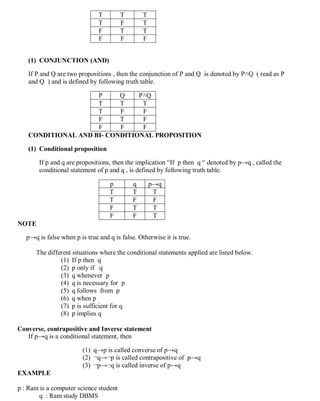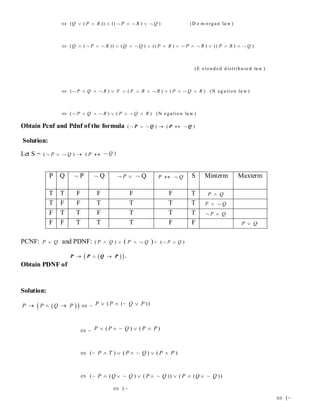This document introduces basic concepts in propositional logic, including:
1. Propositions are declarative statements that are either true or false. Compound propositions consist of simple propositions connected by logical operators like AND and OR.
2. Truth tables define logical connectives like conjunction, disjunction, conditional, biconditional, and negation. Equivalences between statements can be shown through truth tables.
3. Logical implications can be proven without truth tables by showing that if the antecedent is true, the consequent must also be true. Dual statements and De Morgan's laws are also introduced.
![Unit I
LOGIC AND PROOFS
1.1 INTRODUCTION
PROPOSITION (OR) STATEMENT:
Proposition is a declarative statement that is either true or false but not both. The truth value of
proposition is true or false.
Truth table
It displays the relationship between the truth values of proposition.
Negation of a proposition
If P is a proposition, then its negation is denoted by ¬P or ~p and is defined by the following truth
table.
EXAMPLE
P - Ram is intelligent
¬P -Ram is not intelligent
proposition is a declarative sentence which is either true or false but not both.
COMPOUND PROPOSITION
It is a proposition consisting of two or more simple proposition using logical operators.
1.2 LOGICAL CONNECTIVES
(1) DISJUNCTION (OR)
The disjunction of two proposition P and Q is the proposition P˅Q [read as P or Q ] and is
defined by the following truth table.
P Q P˅Q
P ¬P
T F
F T](https://image.slidesharecdn.com/logicandproof-200726210310/85/Logic-and-proof-1-320.jpg)





![p: you will be work hard.
q: you will be rewarded.
¬p: You will not be work hard.
¬ q: You will no tbe rewarded.
Converse: q→ p, If you will be rewarded then you will be work hard
Contrapositive: ¬ q→ p,if You will not be rewarded then You will not be work hard.
Inverse: ¬ p→ ¬ q, if You will not be work hard then You will no tbe rewarded.
Example 4.Prove that 𝑷 → 𝑸 ˄ 𝑸 → 𝑹 → 𝑷 → 𝑹
Proof:
Let S: 𝑃 → 𝑄 ˄ 𝑄 → 𝑅 → 𝑃 → 𝑅
To prove: S is a tautology
The last column shows that S is a tautology
1.3 PROPOSITIONAL EQUIVALENCE:
Logical Equivalence:
Let p and q be two statements formulas, p is said to be logically equivalent to q if p & q have the
same set of truth values or equivalently p & q are logically equivalent if 𝑝 ↔ 𝑞 is tautology.
Hence, 𝑝 ⇔ 𝑞 if and only if 𝑝 ↔ 𝑞 is a tautology.
Logical Implication or Tautological Implication
A statement formula A logically implies another, statement formula B if and only if 𝐴 → 𝐵 is a
tautology.
∴ 𝐴 ⇒ 𝐵 [A logically iff 𝐴 → 𝐵 is tautology, implies B]
If 𝐴 ⇒ 𝐵 , then
A is called antecedent
P Q R 𝑃 → 𝑄 𝑄 → 𝑅 𝑃 → 𝑅 𝑃 → 𝑄 ˄ 𝑄 → 𝑅 S
T T T T T T T T
T T F T F F F T
T F T F T T F T
T F F F T T T T
F T T T T T T T
F T F T F T F T
F F T T T T T T
F F F T T T T T](https://image.slidesharecdn.com/logicandproof-200726210310/85/Logic-and-proof-7-320.jpg)

![≡¬(¬p∧¬q) ∨(q∧¬q ) ∨ ((¬p∧p) ∨(q∧p)
≡¬(¬p∨q) ∨F∨F∨(q∧p)
≡¬(¬p∨q) ∨(q∧p)
≡(p∨q) ∧ (q∧p).
Consider ( P Q ) ( P R ) ( P Q ) ( P R ) (( P Q ) ( P R )) ( 2 )
Using (1) and (2)
(( P Q ) ( P Q ) ( P R )) (( P Q ) ( P R ))
[( P Q ) ( P R )] [( P Q ) ( P R )] T
Prove the following equivalences by proving the equivalences of the dual
(( P Q ) ( P Q )) ( P Q ) P
Solution: It‟s dual is
(( P Q ) ( P Q )) ( P Q ) P
Consider,
(( P Q ) ( P Q )) ( P Q ) P Reasons
(( P Q ) ( P Q )) ( P Q )
((Q P ) ( Q P )) ( P Q )
((Q Q ) P ) ( P Q )
(T P ) ( P Q )
P ( P Q )
P
(Demorgan‟s law)
(Commutative law)
(Distributive law)
( P P T )
( P T P )
(Absorption law)
Obtain DNF of Q ( P R ) (( P R ) Q ) .
Solution:
Q ( P R ) (( P R ) Q )
(Q ( P R )) ( (( P R ) Q ) (D e m o r g a n la w )](https://image.slidesharecdn.com/logicandproof-200726210310/85/Logic-and-proof-9-320.jpg)
